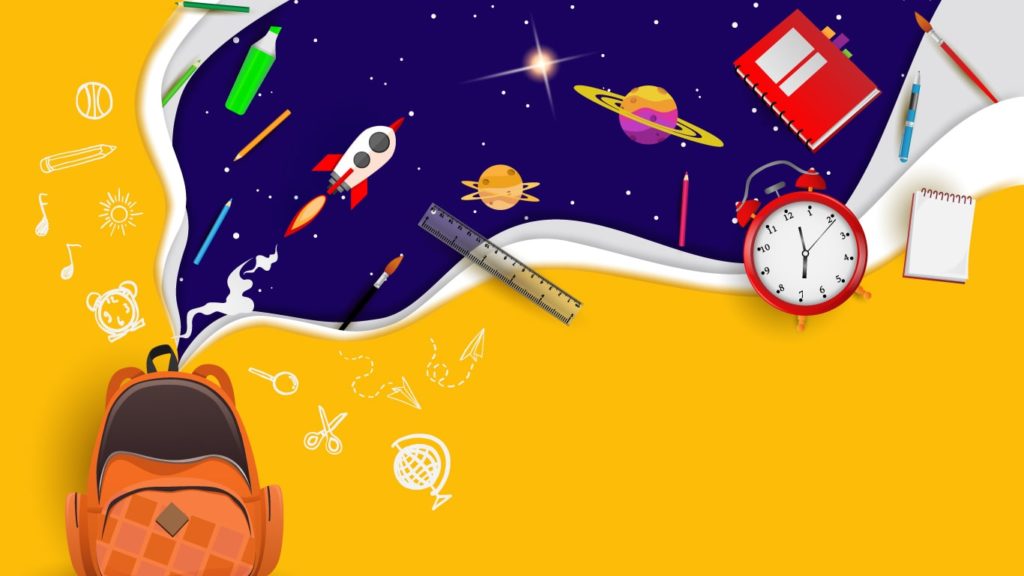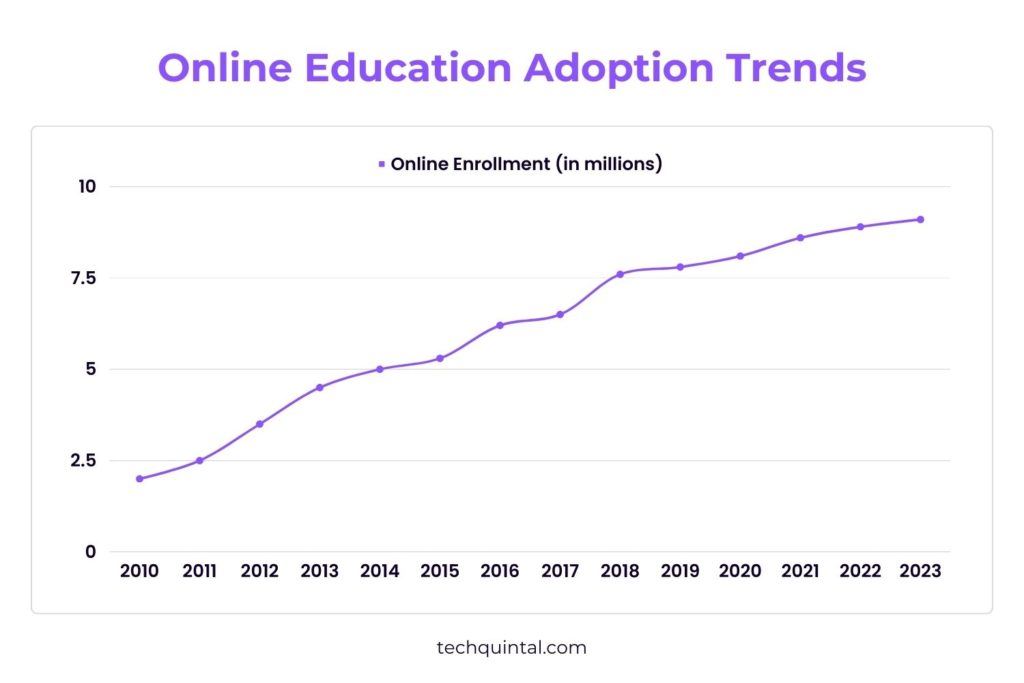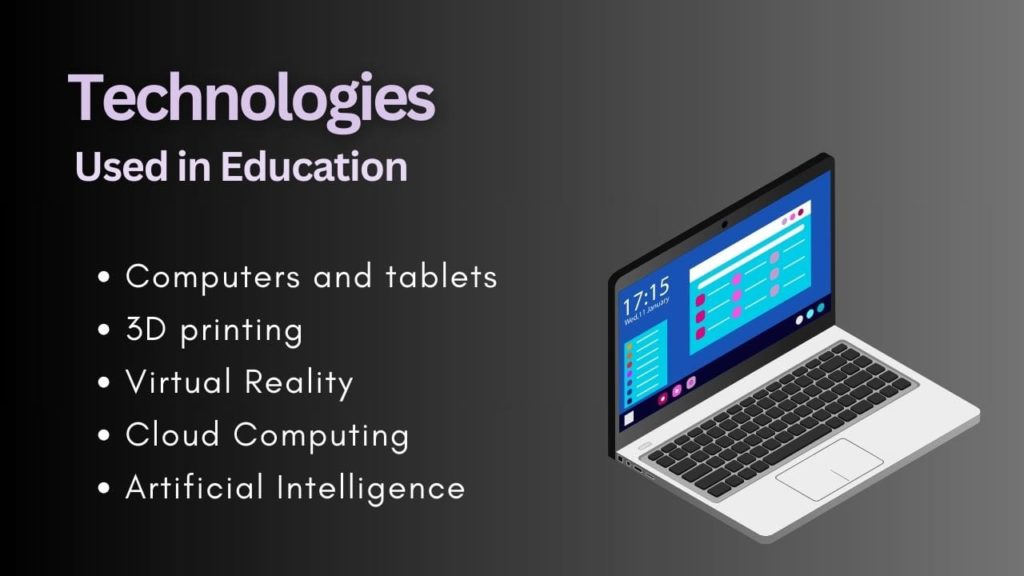
Technology is advancing rapidly, and things we never imagined were possible are becoming an essential part of our lives. The problem is that we often take them as a new normal and don’t give them much thought. It is only when we make a direct comparison to the tools and techniques used in schooling in the past that the growth is glaringly apparent. Modern technology has forever changed classrooms in many ways, one of which is that classrooms are becoming less and less needed. With that said, let’s see how modern technology helps education.
How Modern Technology Helps Education
Modern technology helps education by providing access to a vast array of resources online, thus facilitating self-paced learning that can take place anywhere and at any time. With the opportunity to use digital tools such as virtual classrooms and interactive apps, students and teachers can experience an enriched learning environment where collaboration is encouraged and engagement is heightened.
Let’s explore it in detail –
Online schools and degrees
The first point becomes obvious with the spread of coronavirus in 2020. It forced schools to first reluctantly reduce the number of classes attended physically, then cut them altogether. And, after the initial adjustment, it proved that classes can be held via the live-stream.
That way, each student could sit comfortably in their own home. They only need a microphone and a web camera, and those can be purchased cheaply. This is not a revelation, as the idea has been around for years, but it spread far and wide, reaching parents who were suspicious of its success.
Many students reported feeling joyous for not having to waste time and money traveling to a brick-and-mortar school when asked. Many were able to complete their entire degree through online schooling. Some of those never stepped foot into the city or state the school is in! And, they either had their diploma mailed to their home address or went to a physical location for the first time since they enrolled.

Learning at your own pace and versatility
For those looking to get an additional major or minor, attend bonus courses, earn extra credits, have to juggle part-time or full-time work, raise a family, or take care of their loved ones, modern technology is salvation. Going to school was an obligation that limited time greatly. Either you were able to attend a scheduled class or you were marked as absent, and it hurt your attendance and your grade.
With online classes using modern technology, you can read and study whenever or wherever you are. The concept of certain pupils lagging behind their classmates is becoming less prominent as well. The students can create their schedules and have all the time they need to complete courses.
Freedom of information and resources
The model of homeschooling and online schooling is becoming available everywhere, primarily due to the freedom of resources. Just like with regular school, those resources used to be stacks and stacks of books. And, both students and teachers were often forced to purchase the newest releases to stay up-to-date in their knowledge. Online schooling removed those constraints. Professors can simply purchase and download the latest book publications to their computers.
Then, at their convenience, they will share chapters with their students. Students, on the other hand, can download chapters or entire books at home. This eliminates the need to take notes and miss a part of the lecture because of an illness. They can also study on their computers, or smart devices, or even print them and study the old-fashioned way.
Also, they no longer need to buy and carry books or notebooks to school. Their backs are thankful, that’s for sure. Some students carry their laptops or smart devices and take notes by typing on the keyboard or using a Stylus Pen on a touch screen.
There are also numerous online services that make it even easier to get things done for students. For example, there are many websites that help college students with assignments, do high schoolers their homework, and any tasks that are related to education. The recent enhancements such as ChatGPT, even though a concern, helped students to grasp the knowledge much faster.
Better communication
We mentioned the trouble of a student being less advanced than their classmates as far as learning. The opposite could be true – someone is far more advanced than their peers and was held back by the old educational system. Well, with modern technology, both types of this all the freedom he or she needs.
Professors are just an e-mail, call, or video call away (at reasonable hours, of course). They are ready to provide all of the extra tools, resources, utilities, and answers to questions the students need. This creates a bond between the two groups, and makes learning more fun, interactive, less reluctant to feel “stupid” when they ask a question, and ultimately, better-educated students.
Better grading system
Remember your professors printing out sheets and sheets of test papers, then handing them out to each student? After the testing is complete, they pick them up and grade them using pens. Also, the grades were kept in physical books, which only created bulk and waste the world’s trees as sources of paper.
Well, the technology in the modern world is slowly changing that. IT professionals also develop each test in the form of computer software nowadays. This prevents students from cheating, and teachers from showing bias and giving better grades to their favorite students.
This also eliminates “private consultations” no one can prove. Those happened from time to time, and students mysteriously improved their grades just before the year was over. Also, the grades are sorted into subject lists, showing all of the grades the student earned. Then, those grades are averaged, and all of the students are filed and sorted by school year for easy access.
Better yet, those lists don’t waste paper, and only take a small fraction of the hard drive’s capacity. With regular backups, those can be accessed decades in the future without issues.
Seamless collaboration
Remember the days your students were forced to travel to their schoolmate’s homes to work on a group project? Those days are slowly becoming nonexistent since they have the option to hop on a video call, and share audio, video, and even the screen in real-time.
Furthermore, they can use resources such as Google Docs to edit the same document, thus working simultaneously from their rooms, no matter the distance between them. Students can also share notes, book chapters, or even entire books with a few clicks of a computer mouse, which was unheard of in the past.
Visual improvements
An invaluable effect of modern technology on the schooling system is the visuals. Documents, if formatted correctly, are legible and interesting instead of big, boring blocks of text. Presentations are now colorful, immersive, and are aided by video, audio, or images to illustrate the lecture. Also, today’s laptops can edit and render 3D files. Students no longer need to imagine how things look – they can interact with them on the screen.
Reduced expenses
Schools and universities “waste” a lot of money on tables, chairs, cafeterias, libraries, maintaining the entire property, and security. Don’t forget about updating the school’s computer to newer models, and traveling expenses for teachers.
Today, schools can provide smart devices or laptops to their students and teachers to take home. That way, they can join online classes effortlessly and either talk or listen. The students no longer need to purchase expensive physical books or pay to sit in a library. That way, they can use the money to pay off their student debt. It’s a win-win situation all around!
What technologies are used in education?

Below, we have mentioned a few technologies that are most commonly used in education:
1. Computers and tablets
Computers and tablets are becoming more common in classrooms. With the addition of e-books, students no longer have to worry about carrying all those heavy books from one class to another. Furthermore, the inclusion of computers has also made assignments and homework more information-centric rather than repetitive. They also allow students to access information on the go within minutes and prepare them for handling different technologies from the get-go.
2. 3D printing
Yeah, 3D printing might not sound like a tech that is needed in education, but it has a huge impact. With the help of 3D printing, students can have hands-on experience with life through models, which will be much more interactive and investigative than any picture on a piece of paper. Furthermore, it aids both visual and kinesthetic learners, increases curiosity, and reduces time spent on creating handmade models!
3. Virtual Reality
Virtual reality is already being proposed for extensive use across the board. It certainly has huge potential as far as education is concerned, as it can transform a class into a much more immersive, interactive, and informative experience. It can further inculcate real exploration qualities and also help with your field trips.
4. Cloud Computing
Cloud computing has expanded the limited use of computers in education. When we talk about global education, we have to keep in mind the contribution of cloud computing. Today, resource sharing has become very simple as all the relevant data is stored in the cloud, and accessible to any willing party. By using cloud computing, we can also promote team-building exercises among students without worrying about the logistics involved.
5. AI, or artificial intelligence
AI is certainly making waves. The last couple of years have proven productive for this tech, and if global predictions are right, we are already moving forward in a world that is set for the arrival of AI. AI tools such as ChatGPT have already made schoolwork much easier.
Here is a table that explains all the different technologies used in education:
| Technology | Description | Impact |
|---|---|---|
| E-books | Books in a digital format that can be read on a computer, tablet, or even a smartphone | Reduced the need to carry different books, all information is in one place. |
| Interactive Whiteboards | Allows teachers to interact with the course material using a touch and a digital pen. | It helps the teacher add notes to a chapter in session and makes the class more interactive. |
| Virtual Reality | By using virtual reality headsets, students can experience classes with much more immersion. | It helps with virtual field trips, interacting with the class, and allowing the student to take initiative by exploring the virtual world. |
| Artificial Intelligence | It is a technology that collects and analyzes data to offer a deeper insight | Can help with personalized study materials and help teachers with some repetitive administrative duties. |
| Cloud Computing | A platform for storing and sharing resources | Can facilitate classes on the go, students can learn from their homes, and they can foster teamwork. |
Why do students need technology in classrooms?
We are all aware of the advantages technology brings to our daily lives. It has not only transformed our lives but also our society, opening doors for innovations across the spectrum. One such advancement has been observed in education. Today, classrooms no longer resemble what they were 20 or even 10 years ago, and if things continue to progress at the same speed, we will surely see many more changes.
However, it does raise a question, despite all the good technology does and will do for education, do the students even need it? If we go by numbers alone, EdTech has become a global phenomenon, with a market valuation of almost $6.5 trillion. Even the adoption of tech in K–12 schools has increased by almost 100% in the last two years.
Even teachers find that technology like the internet has a major impact on their abilities in class. So, there is some merit when we say students do need technology in classrooms. In fact, here’s a video that talks about what a modern classroom looks like.
FAQ
Yes. Modern technology helps education in more ways than we can comprehend. The technologies implemented in classrooms, schools, and other educational institutions are inevitable in today’s educational system.
According to a poll, as mentioned by the Indian Times, 60% of internet users are utilizing online learning. Furthermore, 50% of the students who opt for offline learning still use some form of an online platform for their studies.